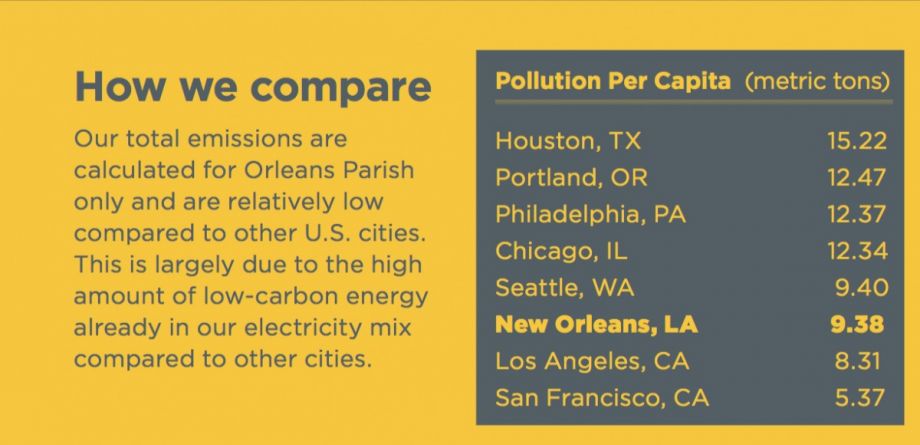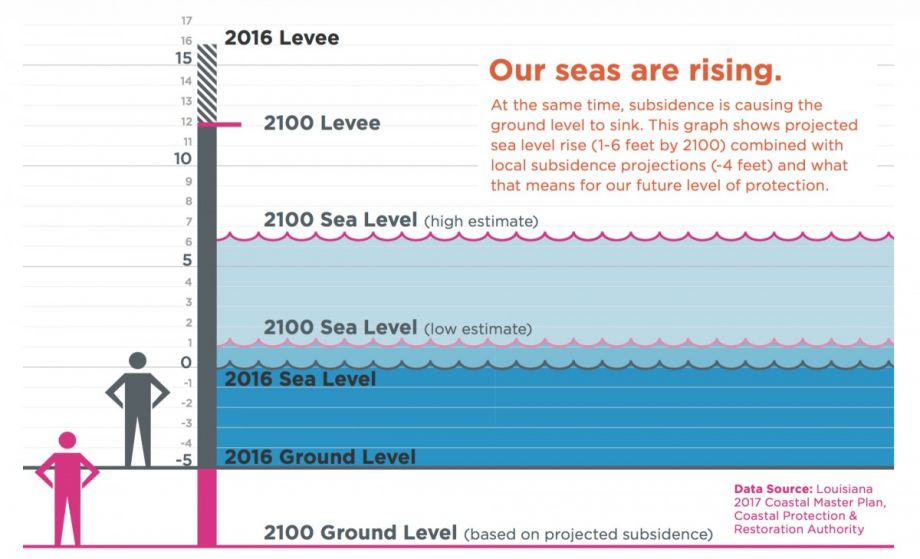Since Hurricane Katrina in 2005, the word “resiliency” in New Orleans has become so much of a buzzword, it’s almost a joke. But climate change is no laughing matter, and there’s a reason the term gets thrown around so much: Being prepared for and able to respond to storms, the severity of which scientists say is the result of climate change, is critical — especially for a city positioned precariously below sea level.
This month, New Orleans joined a number of other U.S. cities in going beyond buzzwords. The city released its “Climate Action for a Resilient New Orleans” plan, which pledges to cut greenhouse gas emissions by 50 percent by 2030. To achieve this goal, Mayor Mitch Landrieu and his team outlined an ambitious set of strategies, including reducing trips in cars by 50 percent, using all low-carbon energy, and diverting waste away from landfills.

(From Climate Action for a Resilient New Orleans)
In a letter introducing the plan, the mayor wrote that the city aims to address rising temperatures and rising sea levels first and foremost. He classified climate change as an “existential threat.”
“If global temperature rises unchecked, New Orleans will not see another 300 years,” he wrote, referencing the city’s upcoming tricentennial next year.
Brendan Shane is the North American regional director with C40, a network of cities working on climate change. He says the New Orleans plan is among the most ambitious of those he’s seen from other cities, which is what one would expect from a city facing such dire and imminent threats. He says New Orleans is going to be completely driven by warming, since it’s already feeling the effects.
“I love the way it’s presented,” says Shane, of the New Orleans plan. “It’s right in your face: Ground level is sinking, sea level rising.”

(From Climate Action for a Resilient New Orleans)
Indeed, according to the U.S. Geological Survey, Louisiana has lost nearly 1,900 square miles of land since 1932. That’s a land mass about the size of Delaware. The mayor’s plan estimates that if greenhouse gas emissions continue at their current rate, the average number of days with temperatures above 95° Fahrenheit could increase by five times in New Orleans, to more than 80 days per year. Subsidence has caused parts of New Orleans to sink 10 feet below sea level.
Shane says that, while New Orleans may be behind some of the megacities that his group works with in terms of setting specific greenhouse gas emission reduction goals, the city may benefit from best practices and up-to-date tools pioneered by existing cities.
“You’re seeing the energy markets and transportation markets moving quickly, so what strategies people use would also change quickly,” Shane says.
A new initiative from C40, called Deadline 2020, encourages cities to have plans in place by 2020 that would substantially reduce carbon emissions to prevent global temperature rise from exceeding 1.5° Celsius, in accordance with the Paris climate agreement. New Orleans is doing just that, and as president of the U.S. Conference of Mayors, Landrieu is setting an example for other city leadership across the Gulf Coast, and the country.
In some ways, because New Orleans has had a resiliency plan in place for some years to respond and adapt to storms, it is doing things backward by developing a mitigation plan after the fact. Shane says that order of operations looks more like cities in Southeast Asia that have experienced severe flooding already, than other parts of the U.S.The New Orleans plan may be aggressive, but is it realistic? Environmental advocacy groups say electric utility provider Entergy’s application for a new, natural gas power plant raises doubts. Entergy is seeking approval from the New Orleans City Council to build a plant that would be used only during “peak” times — hot summer months, or disaster recovery. Logan Burke with the Alliance for Affordable Energy says this contradicts the mayor’s climate plan, and commitment to solar and other sustainable energy sources.
“Across the country, efficient and renewable energy systems are proving to be cheaper and more resilient than carbon-emitting traditional fuels,” Burke said in a statement.
Shane from C40 says changing these types of behaviors — the way corporations think about the energy industry, and the way individuals think about consumption — is the hardest part about enacting these plans once the goals are laid out. He commends the New Orleans plan for including strategies designed to create a culture of awareness and action, both among individuals and the broader economy. Shane says changing behavior on a large scale is tough everywhere, but at least New Orleans is anticipating that.
“So many cities have excellent examples of everything — solar and electric vehicles, better urban design,” he says. “They’ve got elements: The trick is having it scaled out so that everybody’s doing it.”
Correction: This article has been updated to reflect that Brendan Shane, of C40, said that many megacities have already set goals for reduction of greenhouse gas emissions, but that New Orleans has been a leader in resilience planning.

Nina Feldman is an independent journalist focused on audio production. She worked as a regular contributor to NPR member station WWNO in New Orleans and as editor at American Routes. Her work has also appeared on Marketplace, Morning Edition and PRI's The World.
















